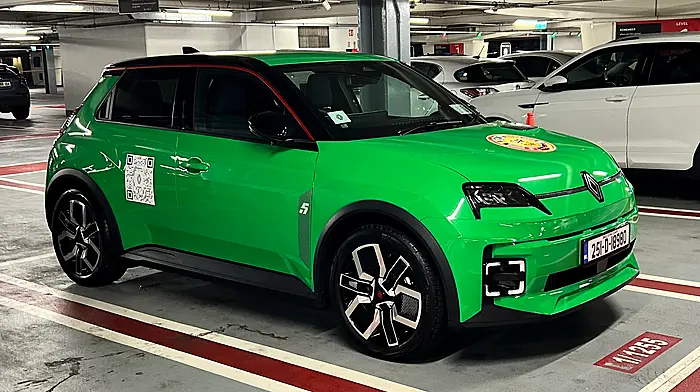BY BRIAN BYRNE
WHILE the saloon car has all but disappeared in most segments with the unstoppable trend towards crossover-SUV type cars, one space where it still dominates is the large luxury car. And the one that stands out particularly in that space is the latest version on BMW’s 7 Series.
At nearly 5.4 metres long, it is noticeably bigger than any of its European competition. Indeed, the only car surpassing it in any dimension is the Bentley Flying Spur, which is shorter but wider. And you could also mention the Mercedes-Maybach S-Class which is a stretch on the MB flagship.
I felt this size quite a lot when driving for review the i7, the electric version of this BMW saloon leader. It’s not that I’m unused to large vehicles, but they’re generally also tall, and the experience in a low saloon with a lot of front and significant length behind the driver does have specific challenges, especially when parking in the typical Irish space that’s designed for something not much bigger than a Ford Mondeo. It was always easy to find in the car park, though, as it stuck out well beyond everything else.

The i7 is nevertheless a handsome car, that same size making the enlarged ‘kidney’ grille that is currently the BMW thing not seem out of proportion on this one. Of course, in the electric car, that grille is now little more than a big badge. The slim LED matrix headlights eyebrowed by daylight running lamps are purposeful in looks, and the sheer length of the i7 doesn’t need any sculpting — its slab-sided style suits a design that is meant to be imposing but not to boast. The Hofmeister kink in the rear windows and the high-set short boot-lid sportify the rear, which also has a distinctive treatment. That boot opens to a 500-litre capacity.
The interior, as it should be, is sumptuous, but with an edgier detail than, say, the cosseting of the Mercedes-Benz S-Class. The multi-reflective styling of inserts on the doors and dash, along with etched aluminium and satin-chrome elements in the seats and head restraints, help provide a very high-end ambience. The very wide screen combining driver instruments and infotainment sections is bright and very high-resolution, offering clear information, but as a physical style thing would benefit from softer corners. Virtual buttons and sliders in a touch-strip in the dash below that screen operate basic climate, though you have to go into the main screen to make larger changes.
It is a given that the car is going to be comfortable for all occupants. But it is especially so for the owner who normally wouldn’t be doing the driving. The left rear seat in the review car was one I obviously wasn’t able to experience in transit myself, but my wife was very taken with it, especially the recline and comprehensive massage functions. Rear passengers also have control of climate and other functions via individual touchscreens in the doors. As a showcase for the latest in technologies, the i7 is a standout success.

This latest 7 Series is totally new generation, and designed from the beginning for the electric era. But BMW hasn’t dumped the combustion engine yet, and the car is available with a range in size, power, and plug-in hybrid. That the first to launch was the electric i7 variant, and also being the most powerful, is significant. Two electric motors on the review car combined to provide both AWD and a thumping, or maybe swishing, 544hp. For a car that weighs 2.7 tonnes the 4.7 seconds 0-100km/h capability is stunning, even more so in that it can be achieved in a silent lack of sound and fury. The rated range is up to 620km, with just the one large battery available. When I charged it to 100pc it gave me an expected range of 486km, but I know from experience that can change, in either direction, depending on driving style and conditions. Whichever, it was enough for all my needs over the review period, particularly as the charging capability is very quick on an suitable high-power charging station.
I drove the i7 over a range of roads and included some long-distance travel. On every surface it performed impeccably, and the nature of the car encouraged smooth driving rather than pumping through the available horsepower and torque, so my average energy consumption proved quite moderate. Of course, I’ll never own one, not least because I’d not be able to afford the chauffeur that this one demands.
VERDICT
What I liked: The sublime electricity of it.
Price: From €140,175; review car €148,017.










